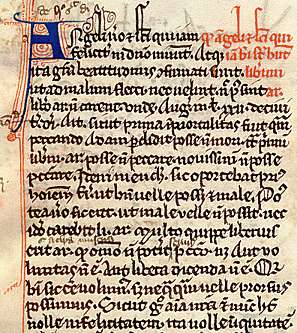 |
The top left of the recto shows a few of the interesting features of the text layout. The rubric headings for each section are not set out in the normal horizontal manner at the top of the section, but form a sort of triangular tab at the top right of the section. This red bit is read as a heading before the main text in black. The letters in the top line are adorned with extended calligraphic ascenders, some of which are curled and split in the manner of English legal documents of this era. Presumably that might encourage us to believe that this is an English production. The first word Angeli is produced with a great deal of decorative flourish. This all seems to point to an elegant and special production, not some scholar's scruffy working text. |
| Then we come to the main text, in a Gothic textura script that is uneven, untidy, cramped and incredibly abbreviated. Just check the transcript against the image if you doubt it. It must be a text for somebody already initiated into some of its mysteries, otherwise it would surely be incomprehensible. The very fine writing which appears above the fifth line from the bottom is part of the gloss, which rambles over, under, around and through the main text, apparently in a single hand. Somebody studied this text very thoroughly indeed. |
|
|
Sentences of Peter Lombard. From a private collection. Photographs © Dianne Tillotson. |
|
|
overview | initials | text
| glosses | alphabet | abbreviations
| exercises | transcript
| translation
| |
|
Click
on each of the above to walk your way through the text. The transcript
will appear in a separate window so that you can use it for reference
at any time. These exercises are designed to guide you through the text,
not test you, so you can cheat as much as you like. |
|
 Script sample for this example Script sample for this example |
 Index
of Exercises Index
of Exercises |
 Index
of Scripts Index
of Scripts |
|
 |
 |